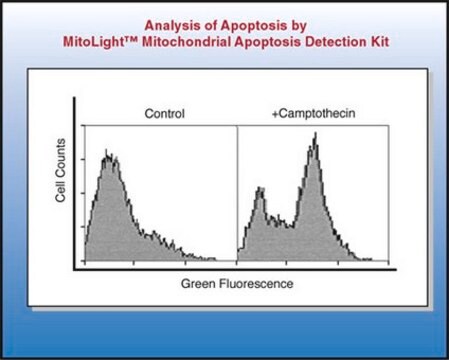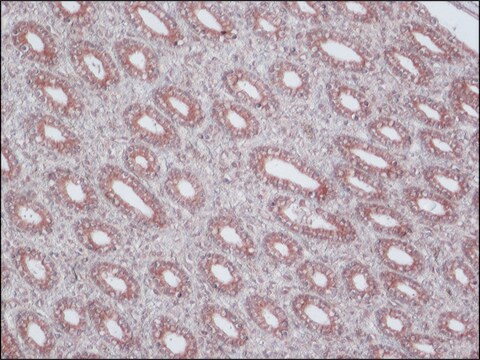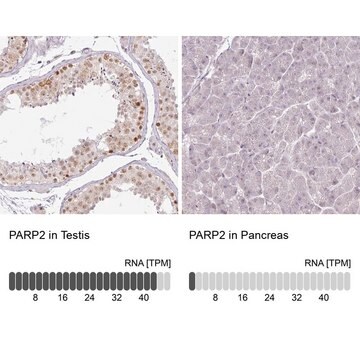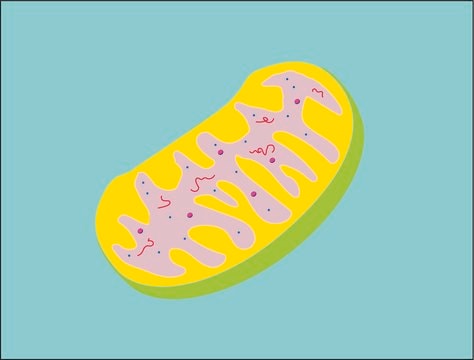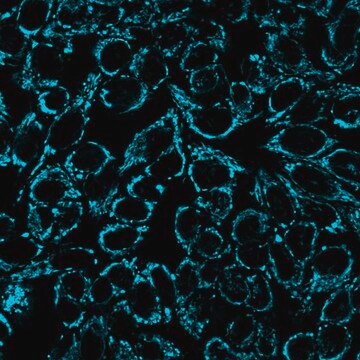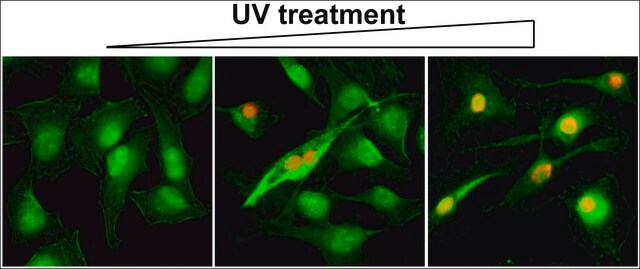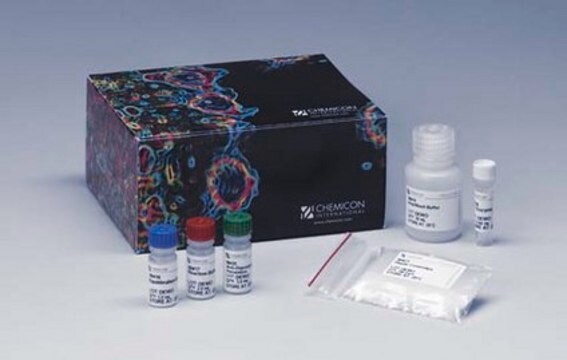APT242
MitoLight Mitochondrial Apoptosis Detection Kit
The MitoLight Apoptosis Detection Kit for flow cytometry utilizes a lipophilic cation, termed as MitoLight, as a mitochondrial activity marker.
Iniciar sesiónpara Ver la Fijación de precios por contrato y de la organización
About This Item
Código UNSPSC:
12161503
eCl@ss:
32161000
NACRES:
NA.32
Productos recomendados
Nivel de calidad
fabricante / nombre comercial
Chemicon®
MitoLight
técnicas
flow cytometry: suitable
método de detección
fluorometric
Condiciones de envío
dry ice
Descripción general
Disruption of the mitochondrial transmembrane potential is one of the earliest intracellular events that occur following induction of apoptosis. The MitoLight Apoptosis Detection Kit utilizes a lipophilic cation, termed as MitoLight, as a mitochondrial activity marker. MitoLight is a mitochondrial dye that stains mitochondria in living cells in a membrane potential-dependent fashion. The monomer is in equilibrium with so-called J-aggregates, which are favored at higher dye concentration or higher mitochondrial membrane potential.
MitoLight partitions differently in healthy cells than in apoptotic cells. Therefore, it has been possible to use a fluorescence ratioing technique to study mitochondrial membrane potentials. In healthy cells, the dye accumulates and aggregates in the mitochondria, giving off a bright red fluorescence (λem = 585-590 nm). In apoptotic cells with altered mitochondrial membrane potential, the dye in its monomeric form stays in the cytoplasm, fluorescing green (λem = 527-530 nm), providing a ready discrimination between apoptotic and nonapoptotic cells. The fluorescence can be observed by fluorescence microscopy using a band-pass filter (detects FITC and rhodamine) or analyzed by flow cytometry using FITC channel for green monomers (Ex/Em = 488/530) and PI channel for red aggregates (Ex/Em = 488/585).
MitoLight partitions differently in healthy cells than in apoptotic cells. Therefore, it has been possible to use a fluorescence ratioing technique to study mitochondrial membrane potentials. In healthy cells, the dye accumulates and aggregates in the mitochondria, giving off a bright red fluorescence (λem = 585-590 nm). In apoptotic cells with altered mitochondrial membrane potential, the dye in its monomeric form stays in the cytoplasm, fluorescing green (λem = 527-530 nm), providing a ready discrimination between apoptotic and nonapoptotic cells. The fluorescence can be observed by fluorescence microscopy using a band-pass filter (detects FITC and rhodamine) or analyzed by flow cytometry using FITC channel for green monomers (Ex/Em = 488/530) and PI channel for red aggregates (Ex/Em = 488/585).
Aplicación
Research Category
Apoptosis & Cancer
Apoptosis & Cancer
The MitoLight Apoptosis Detection Kit for flow cytometry utilizes a lipophilic cation, termed as MitoLight, as a mitochondrial activity marker.
Componentes
MitoLight (Part No. 71616): 100 μL in DMSO.
10X Incubation Buffer (Part No. 71614): 20 mL.
10X Incubation Buffer (Part No. 71614): 20 mL.
Almacenamiento y estabilidad
Store kit materials at -20°C up to their expiration date. After thawing, unused kit components can be refrozen. For best results, aliquot the MitoLight reagent into separate vials to avoid repeated freeze/thaw cycles.
PROTECT REAGENTS FROM LIGHT.
PROTECT REAGENTS FROM LIGHT.
Información legal
CHEMICON is a registered trademark of Merck KGaA, Darmstadt, Germany
Cláusula de descargo de responsabilidad
Unless otherwise stated in our catalog or other company documentation accompanying the product(s), our products are intended for research use only and are not to be used for any other purpose, which includes but is not limited to, unauthorized commercial uses, in vitro diagnostic uses, ex vivo or in vivo therapeutic uses or any type of consumption or application to humans or animals.
Código de clase de almacenamiento
10 - Combustible liquids
Certificados de análisis (COA)
Busque Certificados de análisis (COA) introduciendo el número de lote del producto. Los números de lote se encuentran en la etiqueta del producto después de las palabras «Lot» o «Batch»
¿Ya tiene este producto?
Encuentre la documentación para los productos que ha comprado recientemente en la Biblioteca de documentos.
Los clientes también vieron
Nuestro equipo de científicos tiene experiencia en todas las áreas de investigación: Ciencias de la vida, Ciencia de los materiales, Síntesis química, Cromatografía, Analítica y muchas otras.
Póngase en contacto con el Servicio técnico